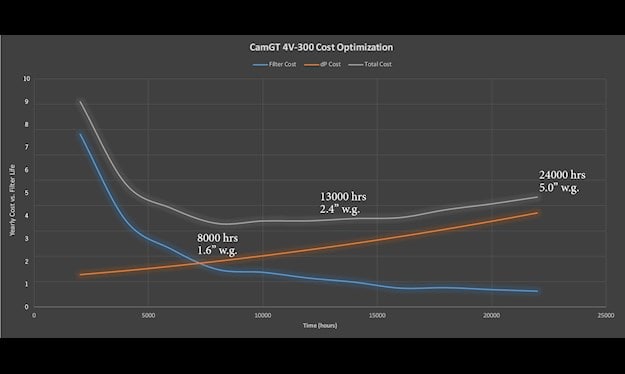Substantial savings can be realised by replacing filters at the right time. The quality of air inlet filters is essential for optimal gas turbine performance. Harmful particulates that bypass filters can lead to power and engine degradation, requiring costly maintenance to recover output. Protecting the turbine with a site-specific filtration solution assures that profits are kept high.
Nevertheless, maximising profitability requires more than a good filter. As a filter loads with contaminants, the rise in pressure drop (dP) impacts overall profitability. Typically, 1” w.g. of dP (250 Pa) reduces turbine power output by 0.375% and increases heat rate by 0.125%. Although you may have planned a scheduled maintenance, an alarm caused by a peak in pressure drop might force an unplanned shutdown for filter replacement to normalise output.
What if there was a better method of replacing your filters? The following points are three strategies to optimise filter change-out:
Since replacement of filters typically means downtime, planners tend to leave filters installed as long as possible, or until a planned maintenance cycle. As noted above, running at a higher pressure drop will reduce the performance of the turbine.
When considering overall profitability, every filter solution has an optimal change-out point that results in the highest operational profits. Graph 1 shows an example of a static filter analysed over time and it clearly demonstrates that by leaving filters in beyond the optimal point (in this case at 8000hrs), additional costs are generated and thus profits are reduced.
Generally, it is more profitable to change filters before the manufacturer’s recommended dP is reached.

*Operating costs:
Value of lost MWh due to decrease in turbine performance
Value of filter replacement costs
Value of fuel
Calculations assumed for base load plant operations
75 MW, 8000 hrs per year, $35 per MWh, 2250 CFM per filter
A CamGT 4V-300 F9 static air filter
with recommended 2.4” w.g. was tested
to determine the most profitable
change-out time. The graph shows that
the optimal time is at approximately
8000 hours (during a scheduled maintenance)
at 1.6” w.g., when total cost
would be the lowest.
The challenge of this trigger is to determine which shutdown date is optimum for the operator. Many plants change filters between 18 - 24 months when pressure drop is higher, however, as demonstrated in Graph 1, letting a filter operate beyond its recommendation could cause pressure drop to increase exponentially, requiring the plant to operate at a reduced load. Consider the following advantages of aligning your optimal change-out point with a scheduled maintenance:
Discover how PowerEye can give you full control of your filters - delivering the continuous monitoring you need to predict the optimal change-out point. Click here to learn more about PowerEye.
Plants typically send filters to a lab for testing every one to two years when they do not have a good monitoring pressure drop system, or if the filter has aged. It is essential to send in filters early since heavy storms or high humidity peaks may cause pressure drop spikes on filters loaded with contaminants. Consider the following: